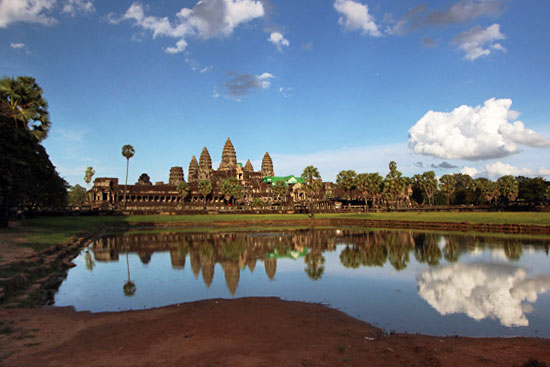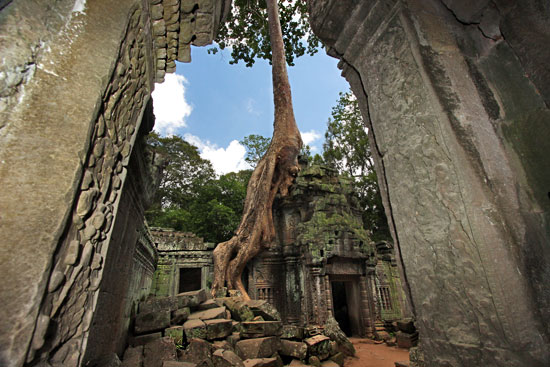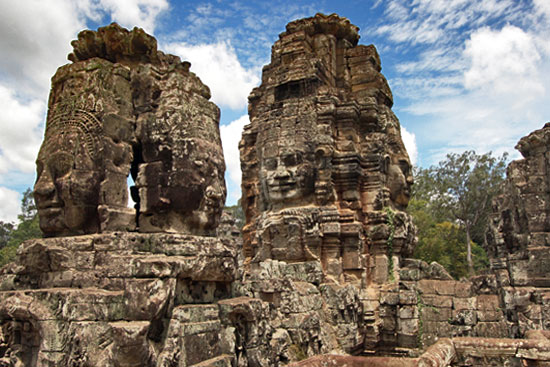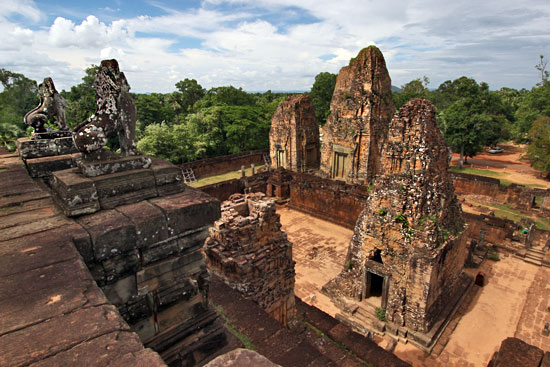Ever since I visited the Angkor Wat Ruins in Siem Reap, Cambodia in 2007, I’ve been itching to go back. Back then, I was on a six-month around-the-world journey and I had allocated only three days in Siem Reap. I was under the mistaken impression that the ancient Khmer site that most refer to as Angkor Wat was a single temple and I assumed three days would be more than sufficient. How wrong I was!

Angkor is the umbrella name for an archeological site that encompasses the different capitals of the Khmer Empire, which ruled much of Southeast Asia from the 9th to the 15th century. Angkor Wat, though an admittedly important religious structure, was a single temple in the Angkor kingdom. Ruins of the Khmer kingdom dot the countryside for more than 400 square kilometers around what comprises the UNESCO World Heritage Site. In three days, I barely scraped the surface, visiting Bayon, Ta Prohm, and a number of the more well-known sites. This time, I was determined to see the many of the smaller, lesser-known ruins.

Having previously roamed Angkor Wat in the gray dead of winter, this time I opted to visit in the middle of summer, not only to escape the crowds in order to capture better photographs, but also to see the site in the lushness of the monsoon season. Though battling the oppressive heat and humidity was a chore, especially at temples that required long climbs on steep stairs to reach the upper levels, I was rewarded with stunning panoramas of red dirt roads cutting like blood vessels through a vermilion jungle throbbing with life. Within the ruins, unstoppable vines clutched carvings and draped down the facades of enormous statuary. I arrived at dawn each day with a few other intrepid visitors, toured until late morning, then retreated to the hotel pool for the worst of the midday heat, returning to the ruins in late afternoon to watch sunset color the rocks and throw mirror images of temples in reflecting ponds.

Words cannot adequately describe the exquisite carvings that cover these temples, including galleries at Angkor Wat that stretch hundreds of feet in length and hold bas-relief carvings of Hindu legends such as the Ramayana and the Churning of the Sea of Milk. Even more remarkable, visitors are still allowed to touch these carvings. By the time Bayon was constructed, the kingdom had converted to Buddhism. King Jayavarman VII ordered giant Buddha heads (which are said to have borne a striking resemblance to the king) carved on all four sides of every tower at Bayon; today more than 200 sets of enigmatic Buddha eyes gaze out in the four cardinal directions. Perhaps even more well-known than Angkor Wat is Ta Prohm, as this ruin was the backdrop for films such as Laura Croft Tomb Raider and Indiana Jones.
Can’t view the above slide show of the Angkor Wat Temple ruins in Siem Reap, Cambodia? Click here.
Though I love Bayon, perhaps as much for the difficulty of photographing it as anything else, my favorite temple was Pre Rup, a smaller ruin that was the second capital of the Angkor empire built by Rajendravarman in the 960’s. It shines pink in the setting sun and from the top, I was able to survey the surrounding landscape for miles in every direction.

Still, even with a week at my disposal, I did not see everything on my list. It would take months to visit all the ruins, and undoubtedly hundreds more unexcavated sites lay just beneath the red surface soil, waiting to be discovered. I will just have to go back again. And again.

You’re so right, 3 days is barely enough to scrape the surface of what the area has to offer. I saw a handful of temples while I was there, but I’d love to go back someday and see some different ones. Great photos!
This great, thanks for sharing. We’re headed to Cambodia this winter, so this is great to pump us up!
Cambodia has a rich culture. Angkor Wat is the one-must-see, as a matter of, more than 700,000 visitors arrived in Siem Reap Provice. Great thing is the tourism put some funds for its maintenance.
Thank you for such a great article that gives just a glimpse of Angkor Wat. I intend to go there one day myself for at least a week to see as much of the ruins as possible. I almost went this year but the money I would have spent going there had to be redirected to my studies when I got accepted into university – a huge shock to my system in more ways than one. But getting back to Angkor Wat from the footage I have seen on a DVD series I have called Journeys Into Buddhism – words and even pictures can’t do the place justice. The place really needs to be seen to be comprehended for all it’s true wonder and beauty.
Hi Matthew: I absolutely agree. As a photographer I’m always trying to capture the essence of a place but, though I think my photos of Angkor Wat are good, they cannot convey the immensity and true wonder of the place that one sees and feels when there in person.
I loved Angkor Wat – it’s such a beautiful, mysterious place. The mind boggles at what the ancient Khmer people were able to construct with what little technology they had (at least compared to today).
Hi Simon: That’s one of the things that really struck me – how on earth did they accomplish this, given the rudimentary tools they had at their disposal?
It was greatly made out of slabs , you see them lying round the temples ..I you look they have holes and notches in them..the big achievement was like Stonehenge ..the stone isn’t local how did they get it there.. they must have had a lot of ele]phants
I didn’t realise it was so widespread. Wonderful photos and summary of this historic and special location.
Stunning!! This place has been on my bucket list for a long time. I’ve heard two things from those who have visited:
1) it takes much long to see than expected.
How many days would you recommend for a serious photographer and first timer to spend there for a first visit?
2) the crowds are insane
When are the best times to go, for the crowds, and your physical comfort?
Tim
Hi Tim:
I absolutely takes longer than you would expect to see it all, especially since the various temple ruins are scattered across 400 square kilometers. A serious photographer would need at least a week – that’s what I did this time and even at that it wasn’t enough. I went back to Bayon twice to get the best lighting and found, surprisingly, that midday was better than the sunrise/sunset times that are usually considered best. Then there is the weather. Crystal blue skies render a different mood that thunderclouds; stormy days have a special charm when the stone blocks become rain-slickened. Frankly, you could probably go every day for a year and never get the same shot twice.
The crowds have a definite pattern. In the monsoon season (summers), a fairy large group gathers at the edge of the reflecting pond in front of Angkor Wat at sunrise, but once the sun is up (~5 a.m.) it disperses and for the next five hours the various temples are relatively uncrowded. That changes drastically when the tour buses start to arrive at around 10 a.m. My plan was to do the more popular sites (Angkor Wat, Ta Prohm, Bayon) in the early morning and concentrate on the smaller, lesser-known sites once the buses rolled in. And as I said in the article, I usually left around noon once the heat and humidity became almost unbearable and returned after 3 p.m. to catch the late afternoon light. In the dry season, the crowds are larger regardless of the hour, however the same patterns apply.
I would love to go to Angkor Wat because I love all kinds of archeological sites but I can’t get any of my friends or family to think about going. I guess they don’t want to be on a flight that long and they are all getting up in age. I thought about going myself but I just can’t see myself going it alone.
Hi Mark: I’m a solo traveler and I go all over the world. If I’d waited for others to accompany e I would never had seen anything. I encourage you to get out there and see things, even if you have to go alone.
Ah, you are as amazing as the places you go.
Thanks Darrelyn! As always, you are one of my biggest boosters.